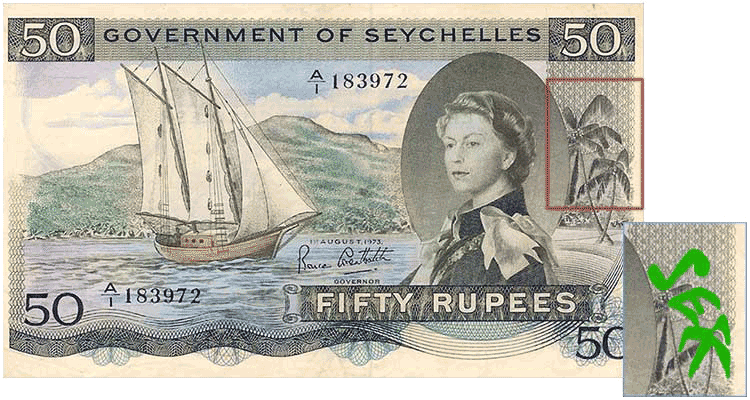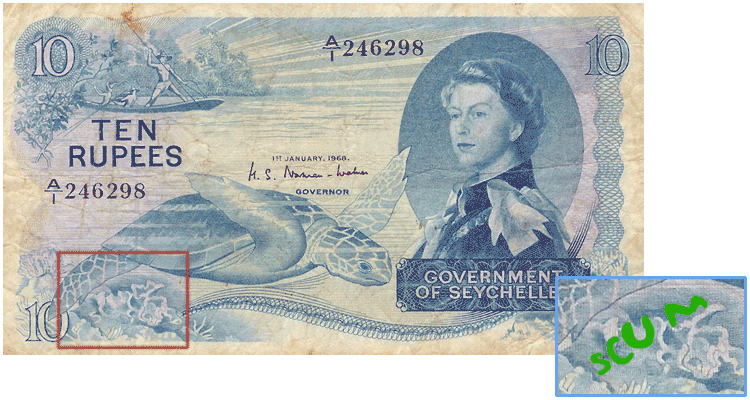Sex and Scum Banknotes: Seychelles Rupees

Although in banknote collecting circles the infamous Seychelles 50 Rupee banknote (p17), which was issued from 1968 to 1973, is well known, this peculiar and well known banknote, which features some distinctive palm fronds spelling the word "SEX" behind the queens head, has a lot of controversy surrounding it.

Very little is known about how this sort of printing "anomaly" happened. Even some senior members of the IBNS (Internation Bank Note Society) cannot agree. In one article on the web the writing is described as an unintentional error whereas another article describes the BWC (Bradbury, Wilkinson & Co., the company responsible for printing these banknotes) banknote engraver as a rogue.
In regards to this allegation, it can be said that the artists who were commissioned to prepare drawings for the whole series, Wendy Day Veevers-Carter and Mary Harwood, were definitely not the culprits as their drawings and designs, which are available for viewing in the IBNS journal (volume 34 no 1) clearly shows a palm tree that in no way spells "SEX", or any other word for that matter. The same article it is explained that the engraver, a man by the name of Brian Fox of BWC* probably altered the original drawings or at least approved the changes to what ended up being the printed version of these famous banknotes of Seychelles. What is not know, and will probably never be known for sure, is whether the changes were an unintentional paper money printing anomaly, of whether the hidden word "SEX" was included on purpose.
Exactly when this hidden word was initially discovered by the wider community is known, as nothing was done to alter the design or retract the banknotes from circulation between their issue dates of 1968-1973**.
One anomaly within a series of paper money is scarce, but may be acceptable. However, a second and much less know anomaly from the same series must at least raise an eyebrow. The notes in this series, with denominations of 5, 10, 20, 50 and 100 rupees, also had a hidden word inextricably located on the 10 rupee banknote (p15).
Under the flipper of the turtle at the lower left of the banknote, the coral is arranged to spell the word "SCUM". The how, why, and when of this is a bigger mystery than the mystery of the 50 Rupee note. It is very hard to conceive, though not impossible, that two coincidences of this nature occur with words that are not particularly complimentary in the same series of notes, from the same printer, and at the same time. It would probably be timely to ask what motive there was to do such a thing to these notes. One plausible idea put forward was that this was done to somehow aid Seychelles in their bid for independence which was started around 1964 and was finally achieved in 1976. It seems the whole thing may have been an intentional insult to the crown, under who's administration the Seychelles were. This is purely the opinion of a few, and no such links have ever been established.

However, there is no doubt that BWC, in producing this series of Seychelles banknotes with their "anomalies", has brought about one of the most highly sought after series of British Commonwealth paper money. Anomalies aside, for their age the designs of these banknotes are truly some of the best in the Queen Elizabeth II series, and a must for collectors of the same.
The Seychelles 10 Rupee note had only two issues in the years 1968 and 1974, whereas the 50 Rupee banknote from Seychelles was issued every year from 1968-1973 with the exception of 1971.
* BWC were taken over by De La Rue sometime after this event so research into this is very limited; the secrecy with which banknote printers must operate is also a contributing factor in the lack of a resolution to this story.
** In a similar incident, where Canadian banknotes included an effigy of the devil in the hairdo of Queen Elizabeth II (devil's hair notes), the banknotes were re-printed with a correction, and the originals were slowly withdrawn from circulation, though many are still available for collectors.





